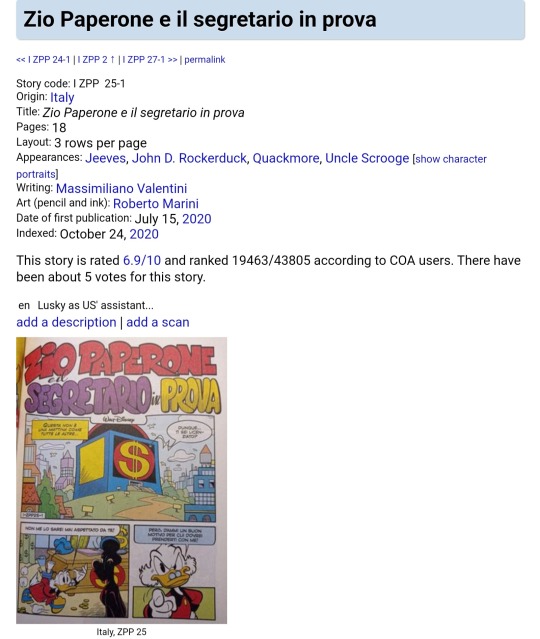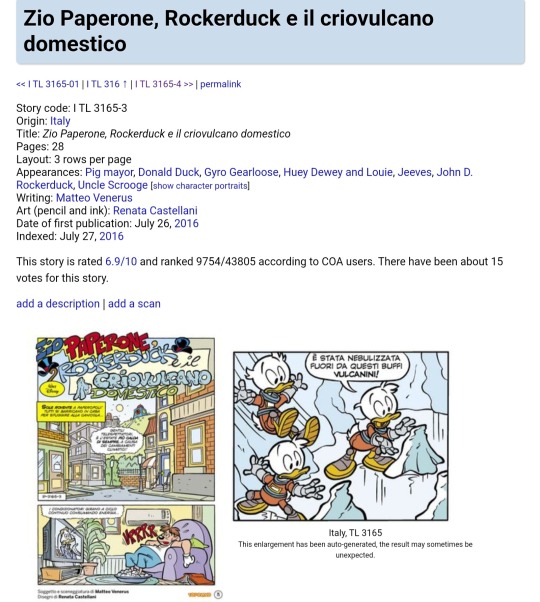#you also have us in a group especially on discord that works on translating comics
Explore tagged Tumblr posts
Text
@quack-duck-comics has translations of Italian comics into English, so if you're interested, feel free to look there. @bitterlynsposts





IAM SOOO MADDDDD, WHY CANT I SPEAK ITALIAN. ITS SO UNFAIRRRRRRRRRR. Ill probably try to start learning italian just for duck comic (ノ´Д`)ノ





I DESPERATELY NEED THEMMM, my stupid country dosen't have them WAHHHHHH.
(ignore me, im just being a crybaby)
#i know this feelings#i have the same but don't worry you have comics that are translated into english by fans#you also have us in a group especially on discord that works on translating comics#somehow I will also translate my comics into English#since unfortunately most Egmont comics are not translated#italian disney comics#disney duck comics#duck comics#disney comics#comics#scrooge mcduck#john d. rockerduck#disney ducks#donald duck#miss emily quackfaster#jeeves#lusky#huey dewey and louie#other characters#disney dog#disney duckverse#duckverse#panini comics#italian comics#topolino
30 notes
·
View notes
Text
INTERVIEW: Roland Kelts On Fantasy Worlds And The Impact of Streaming
Roland Kelts, half-Japanese author of JAPANAMERICA: How Japanese Pop Culture Has Invaded the U.S., has made a name for himself covering the unique nuances of American and Japanese cultural-exchange. Kelts recently presented a talk titled "Anime and Race" with Arthell Isom for this year's Virtual Crunchyroll Expo. We had the opportunity to ask Kelts a few questions about the impact of streaming, adapting international webcomics, the appeal of isekai, and of course, Twitter.
English-language and Japanese-language editions of JAPANAMERICA
With Crunchyroll hitting three million paid subscribers as of July, it’s evident that anime streaming is thriving, especially with young adults. Simulcasts now allow essentially anyone access to the latest hours after airing in Japan. How have you seen this constant finger on anime’s pulse change how fans engage with Japanese pop culture, versus the heavily curated experience of exclusively watching whatever made it to American television networks?
Everything’s faster. Fans I meet from Boston to Kansas to Los Angeles now ask me about shows that were just released months or even weeks ago on my TV in Tokyo. And simulcasts have also made the US fans hungrier, more demanding, sometimes even whiny. (“Why don’t we have this yet? When’s this coming out? Where’s that title?”)
At the same time, it creates a zone of delusion, a kind of third universe between the US and Japan where fans think they know everything that’s happening in Japan and what’s right and wrong about the anime industry and how it works just because streaming media delivers the entertainment they want when they want it.
I still call that third universe JAPANAMERICA, neither here (Japan) nor there (US) but some kind of hybrid space, and in some ways streaming has only expanded its borders.
Image via Netflix
Anime produced and released for streaming services have seen major cultural impact lately. In 2018, Netflix released Devilman Crybaby to critical acclaim, and more recently Crunchyroll has begun streaming its own originals shows like Tower of God in 2020. In previous interviews, you’ve described younger animators butting heads against the old guards in Japan’s traditional anime industry, compared to other industries like games or design. Nowadays, you have younger studios such as Studio Trigger and Science Saru signing streaming deals to distribute their shows to a wider demographic. Do you see this pivot to web-original anime as a way for younger animators, producers, and even veterans to exercise new ideas they may otherwise not be able to explore?
Definitely. Masaaki Yuasa told me that if it weren’t for streaming services, Devilman Crybaby would be an old-school OAD collecting dust in the adult video corner of Tsutaya that may have aired once in wee-hour programming on domestic Japanese TV.
Two years ago, Go Nagai, the manga artist who created the original Devilman in 1972, told me backstage at Anime Expo in Los Angeles that streaming was the only reason he’d been invited to Los Angeles. “Hey, I’m an old man,” he said, laughing.
There were always innovative upstart studios like Trigger. The difference is that web-original anime and streaming platforms get Trigger’s works screened in major American cinemas by national distributors like GKIDS, and around the world online, and gets Trigger artists and people like Yuasa and Nagai the VIP treatment at overseas anime cons.
Emilia and Subaru from Re:Zero
One of the biggest trends in anime recently is the boom of a genre called “isekai,” i.e “another world” stories where average protagonists get transported into fantastical worlds. In the last ten years, isekai has already explored virtual reality MMO worlds like Sword Art Online to self-aware “Groundhog Day” stories like Re: Zero. Although portal fantasies have always been present in traditional Japanese folklore and a staple of global speculative fiction, why do you think this particular narrative may have gained so much traction with young adults recently?
One of the trends I write about in JAPANAMERICA is how the constant presence of the internet in our lives can diminish our satisfaction with the real worlds we inhabit.
You’re right, of course: portal fantasies have long been a part of Japanese literature, folklore, fantasy, and spirituality.
But the world-within-the-world of the internet has arguably overtaken our realities. It’s not only ever-present, it’s superior: brighter, freer (we can click on anything and almost immediately see and hear what we want), and faster. It’s also portable and ubiquitous.
Many of us greet the morning not as sunlight through our blinds or the sound of birdsong, but as the OLED or LCD light from our smartphone screen. Our sense of “home” is the emails we recognize, the apps we check, our news, our weather, our sports updates. It ain’t called an “I” phone for nothing. Online, everything’s for me.
So it makes a kind of sense to me that young adults might be kind of bored with stories that don’t feature immediate and easy access to virtual realities and other worlds and role-playing lives. Stories without isekai-type narratives might feel outdated, boring, even irrelevant to the way we all live now.
Original creator comics, such as Webtoon series like God of High School, have recently been adapted into series exclusively streamed on Crunchyroll. Series like God of High School feature diverse characters from all across the world in a tournament set in Seoul, a setting we rarely see in television anime. Although many Japanese web novels and amateur projects have since been adapted into professionally produced shows, such treatment is less common for non-Japanese properties. In terms of broadening the horizons for intellectual property, did you ever anticipate the world of Japanese animation and international webcomics to cross paths?
I wrote about it in JAPANAMERICA and thought it would happen sooner, actually. On book tours at anime cons, fan artists and amateur comics artists ask me to sign JAPANAMERICA and hand me a copy of their own work in return. I’d read their work on the plane to the next city and sometimes I’d think, this might make a great anime series or feature.
But I couldn’t generate much enthusiasm when I got back to Japan. Part of the problem was obvious: language and culture barriers.
But also, the Japanese industry is sitting on piles of great intellectual property from decades of manga about every imaginable type of topic and character, plus all the great doujin fan-art that powers the record crowds at the biannual Comiket and fills the floors at Mandarake. Why would they reach overseas to work with someone who doesn’t speak the language and/or understand the codes of cultural and business behavior to take a risk on a property from a foreign land?
Obviously, the increased involvement of non-Japanese producers like Crunchyroll and others are changing that. Also, newer generations of artists from outside Japan have an even greater sense of how Japanese-made anime works, how it gets made, and how to behave in Japanese business transactions. Plus, I do think online translators, as bad as they may be, have helped ease the transition between languages on both sides, Japanese and non-Japanese.
Tokyo Big Sight during Comiket 96 last year (photo by Daryl Harding)
Fourteen years ago, there was no such thing as Twitter. It goes without saying it’s huge now, especially among anime fans. With major events like Comiket canceled this year, alongside dozens of conventions in the states, more fans than ever are converging online. Nowadays, it’s not only incredibly easy to find anime, but also discover a whole community buzzing with activity regardless of what language you speak. How much of a role do you think social media has played in pushing anime from niche to ubiquitous, and what do you hope to come out of this zealous digital convergence for fans everywhere?
I write about the importance of fan forums and chatrooms in JAPANAMERICA. Anime fans were one of the key drivers of Usenet groups and BBS sites back in the day. In a chapter I called DIY (“do it yourself”), I explain how anime fandom is a bottom-up phenomenon, fired by shared communal passion and the sharing of that passion.
But I didn’t know how massive social media platforms would become, or how crucial they would be for Japanese pop culture fandom.
What sucks is that the discourse on social media is so coarse. When you go back and read exchanges between diehard anime fans on Usenet and old chatrooms and forums from the mid-2000s, they read like middlebrow literature compared to what you see on Twitter, Reddit, and Discord. So many social media posts are made just to get hits, not to communicate or share ideas, and the most provocative, cruel, or just plain daft stuff gets liked and retweeted a thousand times.
An ex-friend of mine once told me he was going to market his book entirely on Twitter. I said, well then you’ll get a bunch of responses from people who don’t read a lot of books. But he said he just wanted to sell a lot of copies. He didn’t care about the quality of the people who read them or followed him.
But I guess that’s the state of most things in America right now, politics in particular. Mass appeal is all that matters.
Roland Kelts' blog can be found here. Follow him on Twitter at @rolandkelts!
More information on JAPANAMERICA can be found here. A Japanese-language edition is also available from Kodansha.
Blake P. is a weekly columnist for Crunchyroll Features. He is still thinking about Hellshake Yano. His twitter is @_dispossessed. His bylines include Fanbyte, VRV, Unwinnable, and more.
Do you love writing? Do you love anime? If you have an idea for a features story, pitch it to Crunchyroll Features!
0 notes
Text
The Force of Funding: How Star Wars Fans Stay Positive
Fandom has always been a challenging field to navigate.
When you take a large group of people who are passionate about something, mix in contradictory opinions, disappointment, and the internet’s ability to instantly connect fans with content creators, actors, and other creatives, it’s easy for fandom to turn toxic. But what happens when fandom takes their disappointment and their passion and turns it into something positive?
The Star Wars fandom has never been immune to toxicity. Infamous fans — or rather haters — are known for harassing Star Wars: The Phantom Menace performers Ahmed Best and Jake Lloyd. Despite the critical success of Star Wars: The Last Jedi, actress Kelly Marie Tran deleted Instagram due to fandom backlash, following Daisy Ridley’s 2016 social media departure.
In 2018, an academic report revealed that haters had been weaponized by Russian trolls to sow seeds of discord in the wake of The Last Jedi, leading a strategic campaign against director Rian Johnson, members of the cast, and vocal fans on social media. Data analyst, Katie McCort, identified a systematic pattern of targeted harassment against female Star Wars fans by analyzing thousands of tweets between 2017 and 2019.
It would be easy to counter hate with hate, but fans have actively fought against perpetuating a toxic narrative within the Star Wars fandom. Following the release of Star Wars: The Rise of Skywalker, disappointed fans of Adam Driver’s character Ben Solo banded together to show their gratitude by raising funds for Driver’s non-profit Arts in the Armed Forces.
In one month, over four thousand fans contributed to the fundraiser, raising a total of $90,000 (after processing fees, $86,413 was donated to AITAF). This is the sort of positivity that should be uplifted and celebrated in fandom space. While people from all walks of life contributed to the fundraiser, the majority of the fans were members of the Ben Solo fandom and the overlapping Reylo fandom (those who ship the characters Ben Solo and Rey).
When Star Wars author Charles Soule announced on April 15th that he would be hosting a benefit auction for the Book Industry Charitable Foundation, Star Wars fans were quick to jump at the opportunity to lend their support to comic shops and indie bookstores. For the first auction item, Soule agreed to appear on a Star Wars podcast for an in-depth discussion.
The second auction item was a signed copy of Soule’s wildly successful Rise of Kylo Ren comic, as well as a 500-word non-canon and unofficial story about Ben Solo or Kylo Ren with art by Will Sliney. Brad Whipple started the first GoFundMe fundraiser to help “fans around the Star Wars community who want to contribute” and “guarantee Ben Solo’s newest story is told to all fans!”.
Yet again, the draw of Ben Solo inspired fans to come together, already raising over $13,000 between the two auctions in just four days. Brad Norris organized the second GoFundMe fundraiser to bid for Soule to appear on the What The Force podcast.
Interviews
I spoke with a few of the fans at the forefront of the campaign to get a closer look at their involvement, their love for Ben Solo, and the impact of positivity in fandom.
Brad Whipple is the host of Friends of the Force Podcast and the driving force behind the GoFundMe fundraiser to bid on the unofficial short story. Whipple explained that “the majority of people, especially during COVID-19, can’t afford to donate $700+ individually on a comic book. But when we’re talking about a $5 donation? That’s a lot more realistic.” He was shocked by how quickly the fundraiser grew: within 45 minutes, they had raised over $1,000.
“A lot of people are saying [that] this is the happiest they’ve felt in months because we’re getting a new Ben Solo story in addition to helping charity.” The draw of Ben Solo has certainly helped the success of this campaign, as well as past efforts. “I think [it] shows that movements like #SaveBenSolo do ultimately have a positive impact.” Whipple believes that a character like Ben Solo “gives us all hope that even in the worst circumstances, we can come out on top, and I think that’s why he resonates with so many fans.”
Whipple noted that the money that has been raised by the campaign would help to change someone’s life and help businesses stay afloat during the COVID-19 crisis. “At the end of the day, I think everyone will be thankful for whatever new story that we get because it will help us keep the love for Ben Solo alive, give us hope that maybe we haven’t seen the last of him, and enable us to be a positive force for change in our communities during one of the most pressing circumstances of our lifetime.”
Brad Norris started his GoFundMe page after seeing Brad Whipple’s. He was drawn to the fundraising efforts, “As a person who worked in an independent bookstore in Chicago all through college, and who loves comics, and my local comic shops, it is a cause I can get behind in a heartbeat.”
Once he saw that Soule was auctioning off an appearance on a podcast, he knew exactly which podcast he wanted to have that honor. As a Patreon supporter of Marie-Claire Gould’s podcast What the Force, he reached out to her to see if she would be comfortable with the opportunity before he set up the GoFundMe.
Norris believed that the campaign was one that all Star Wars fans could get behind. “However,” He was careful to point out, “within that fandom, it’s Reylos who have moved monetary mountains to support causes like this that center around Ben Solo.” A sentiment that the author of this article agrees with. Consistently over the years, Reylos and Ben Solo fans have turned frustration into donations, making a positive impact in the world.
“Charles Soule knocked it out of the park with his The Rise of Kylo Ren comic series, and the fandom was so hungry for more Ben Solo content after The Rise of Skywalker.” Norris continued, “I don’t think there’s another single character in current fiction that has united as many people around them as fervently and continuously as Ben Solo. And it’s great to see that love translate into real-world charity and assistance for people in need.”
Marie-Claire Gould was overwhelmed by the opportunity to interview Charles Soule when Norris reached out to her. Before the GoFundMe began, both he and another fan and friend of the podcast had already committed to a $300 bid. After Soule upped the ante by offering to answer an ‘I shouldn’t answer the question’ if the fundraiser reached $1500, and additional questions for each additional $500s, she has been looking for ways to drum up interest on social media.
“There is an [misperception] on who consumes Star Wars media now. The base of fans interested in feminine gaze has grown over the last five years to the point of pushing comics to be sold out. Ben Solo fans are a huge factor in that, as a character, he is identifiable to many people who consume feminine gaze media, and [he] drives a desire to have more content and stories about him.”
While Ben Solo is certainly a draw for the short-story auction, Gould also praises Soule as “a trusted creator of Star Wars content for a long time, his handling of Poe, Anakin & Obi-Wan, Vader and the Fall of Ben Solo all required a careful touch. He is a thoughtful, thematic, and symbolically driven creator that many in especially the female side of the fandom were drawn to even before he took on Ben Solo.”
Gould tempers her enthusiasm, wary of the double-edged sword of positivity. “[When] anything positive happens in fandom [it] tends to come with backlash driven from the global village wanting to judge what others enjoy in fiction. I think people should focus on the positive things we produce and ignore the negative. As George Lucas said, “Seek Joy,” and you will know you are on the right path.”
Evie Giacomo used to work in comics, she was inspired by everyone’s enthusiasm for Soule’s campaign and found herself quickly outbid. “The fact that everyone wanted to pool their money together so we can raise more money together than any one person alone and share Soule’s story widely meant a lot.”
She also participated in the AITAF campaign, “I especially love how Joonas Suotamo threw his energy behind the campaign, too.” Referencing the Chewbacca actor’s promise to participate in the viral #BenSoloChallenge if fans got the fundraiser to $75,000. Vee noted that this is how the Ben Solo and Reylo community responds, “We turn those negative feelings into something positive.
We really latched onto the AITAF campaign and poured a ton of energy and money into it.” She also pointed out that the fandom “decided to channel our misgivings with Episode IX into campaigns thanking Daisy Ridley and Kelly Marie Tran for their performances and role in shaping Star Wars.” Her favorite fundraising campaign, however, was the Reylo Charity Anthology, which raised $25,000 between two volumes for non-profits like RAICES, Save the Children, and many others.
For those who donate to the campaigns, Giacomo decided that she wanted to find another way to give back and incentivize supporters. “For the past few weeks, I’ve been making little needle-felted blue butterflies inspired by [Star Wars Roll Out: Ben Solo and the Bug Hunters Chapter 2]. For anyone who donates to the campaigns and shares a screencap confirmation with Giacomo, she is raffling off a handmade felted blue butterfly.
With two days left in the campaign, Whipple wanted to “thank everyone who donated to this cause. It has been such a bright spot for many during these tough times we’re living in, and I think this will all be something we can look back on with our Star Wars family and remember the positive impact we made.”
Conclusion
Unfortunately, toxicity tends to garner more attention and page clicks across pop-culture news. It’s important to remember that there is an incredible fanbase that is dedicated to spreading positivity and helping where they can. It is often easy to listen to the loudest, angriest, and most hateful voices — but there are forces of good within the Star Wars fandom that are giving their time, money, and creative efforts to make a change wherever they can.
The Ben Solo and Reylo fandom are just one part of the Star Wars fandom, but they deserve a round of applause for everything they have done. While the character of Ben Solo may have met an untimely demise in The Rise of Skywalker, fans keep the legacy alive through charitable acts of goodwill.
Charles Soule’s auction ends on April 20th. At the time of this article’s publication, fans have raised nearly $15,000.
The post The Force of Funding: How Star Wars Fans Stay Positive appeared first on Your Money Geek.
from Your Money Geek https://ift.tt/3cwiTUZ via IFTTT
0 notes